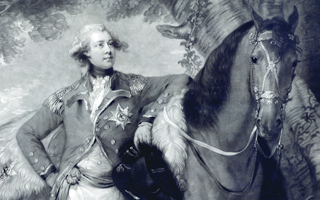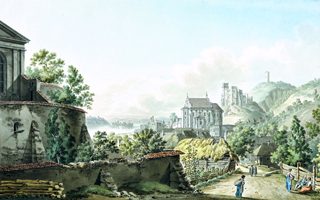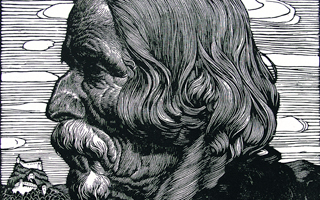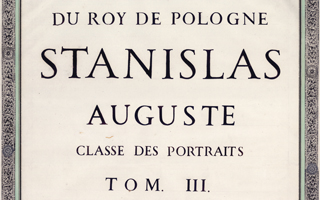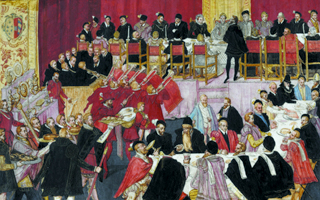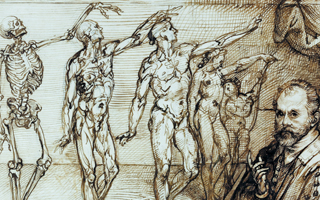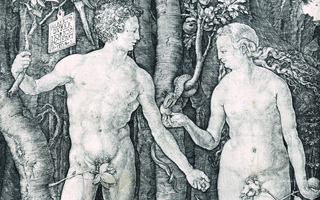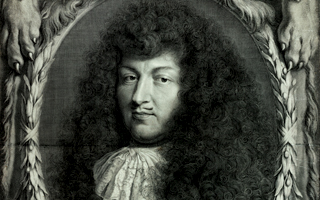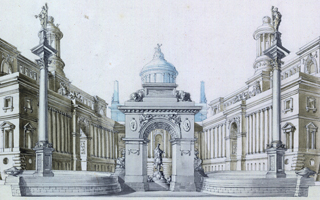Print Room
Opening hours:
- Monday – closed
- Tuesday 9 am – 6 pm
- Wednesday – closed
- Thursday 9 am – 6 pm
- Friday – closed
3rd floor, room 343
phone: +48 22 55 25 830
e-mail: gabryc.buw@uw.edu.pl
The University of Warsaw Library Print Room established in 1818 has been the oldest public collection of prints and drawings in Poland, and by 1939 it had been the largest one too. Despite extensive losses suffered during World War II it has retained an outstanding position in the history of Polish collecting and collections due to the artistic and historic value of its holdings. At present the collection includes approximately 50,000 master and architectural drawings, single leaf prints and bound volumes of prints spanning the 16th to 20th century. Nearly all West European schools of graphic arts are present and the majority of works reflect 17th and 18th century artistic output in the field. The Print Room acquires, houses, preserves and provides access to the collections of prints and drawings and their curators are involved in various scholarly, exhibition and educational projects and activities.
History
The core of the holdings consists of King Stanisław August’s Print Room purchased for the University of Warsaw from the King’s successors in 1818. The collection includes (mostly 17th and 18th century) prints and drawings the majority of which are arranged according to their subjects and placed in characteristic boxes covered with leather, so-called royal portfolios. In the period between 1818 and 1821 Stanisław Kostka Potocki, who proposed the purchase of the afore-mentioned collection, donated to the University of Warsaw a considerable part of his own collection. All objects in question were transferred to the University of Warsaw Library opened in 1816 and the traditional name of the royal collection was assigned to the collection of all graphic works owned by the University.
After the collapse of the November Uprising the Print Room collections were transferred to Saint Petersburg, Russian Empire (1832), incorporated in the holdings of Academy of Fine Arts and expanded with the collections owned earlier by the Friends of Sciences Society in Warsaw and Eustachy Sapieha from Dereczyn. In 1923 the resolutions of the Treaty of Riga resulted in the restoration of the collections in question to the Library. In the period between 1924 and 1939 the collections were enhanced with acquisitions, such as the Archives of Tylman van Gameren, collections of Dominik Witke-Jeżewski, Izydor Krzemicki and Henryk Grohman.
World War II was a tragic period in the history of the Print Room, which suffered the loss of nearly 60% of the collection, including the reference library, photograph archives, inventories and catalogues. The Nazi occupying forces pillaged the most valuable objects and a large part of the collection was torched in the building of Krasiński Library after the collapse of Warsaw Uprising in 1944. The decisive attempts at reclaiming looted and lost properties immediately after the end of World War II enabled the Library to regain its severely decimated holdings and the Print Room was reopened as early as January 1946.
Collections
Old Master Prints
The Print Room boasts objects from nearly all schools and periods of European printmaking. The most outstanding collections include early Italian and German engravings (Andrea Mantegna, Marcantonio Raimondi and his school, all series of prints by Albrecht Dürer). The 16th century Netherlands and 17th-18th century Flemish and Dutch schools are reflected in the works of Lucas van Leyden, Sadeler family from Antwerp, Jacob Matham, Adriaen van Ostade, Wallerant Vaillant and others. Moreover, the Print Room houses a magnificent collection of prints from the school of Peter Paul Rubens which represent his paintings and the collection of Rembrandt van Rijn’s graphic works which is the largest in Poland.
The 16th to the 18th century Italian school involves the most outstanding engravers and painters dedicated to graphic arts: the inventor of monotype technique Giovanni Benedetto Castiglione, the poet and landscape painter Salvator Rosa, the author of polonica Stefano della Bella. Attention should be drawn to the unique collection of nearly complete graphic oeuvre of Giovanni Battista Piranesi from King Stanisław August’s library.
French masterpieces of the 17th and 18th century include the remarkable etchings by Jacques Callot and copper engravings by outstanding portraitists Robert Nanteuil and Gérard Edelinck. The collection abounds in French and English colour prints and English mezzotints. Finally, the Print Room holds a unique collection of chiaroscuro woodcuts from, the largest collection of that type in Poland (over 200 impressions), including works of such a master as Ugo da Carpi.
19th and 20th century Prints
The collection documents relatively well the development of lithography with works of foreign (Achille Devéria, Honoré Daumier, Gavarni) and Polish artists (Aleksander Chodkiewicz, Jan Feliks Piwarski, Maksymilian Fajans).
The beginnings of modern graphic arts are represented by the works of masters from the second half of the 19th and early 20th century, including the French (Camille Corot, Edouard Manet, Henri de Toulouse-Lautrec), the Germans (Max Liebermann, Max Slevogt), the Belgians (James Ensor and more than 200 works by Félicien Rops), the English and Americans (Frank Brangwyn, James McNeil Whistler), the Scandinavians (Edvard Munch, Anders Zorn) and finally the Czechs (Emil Orlik).
The comprehensive collection of modern Polish prints includes the works of Leon Wyczółkowski, Józef Pankiewicz, Władysław Skoczylas, Feliks Jabłczyński, Konstanty Brandel, Jan Skotnicki, Wojciech Weiss and Tadeusz Makowski. The Warsaw graphic artists from the interwar period are also well represented: Stefan Mrożewski, Stanisław Ostoja-Chrostowski, Tadeusz Cieślewski Jr., Wanda Telakowska. Achievements of the second half of the 20th century are shown in the works by Jonasz Stern, Jerzy Panek, Józef Gielniak and Jan Dobkowski. Most of the prints from the turn of the 19th century (more than 1,000 items) were donated in 1939 by Henryk Grohman.
Master Drawings
The collection of highly diverse nature includes approximately 3,500 drawings by masters of various European schools (often represented with only one work), Polish and foreign artists active in Poland. Most eminent objects originate from the collections of King Stanisław August, Stanisław Kostka Potocki and the Friends of Science Society in Warsaw.
The abundant collection of works from the Italian school (16th–18th century) includes pieces by such artists as Perino del Vaga, Giorgio Vasari, Alessandro Allori, Bartolomeo Passarotti, Elisabetta Sirani and Piranesi. Equally outstanding names draw viewers’ attention to the collection of 16th century Netherlands and 17th century Flemish and Dutch works, including the design of stained glass window by Pieter Coeck van Aelst, miniatures from the circle of Frans Floris documenting the marriage of the Duke of Parma Alessandro Farnese to the Duchess Mary of Portugal, landscape masterpieces by Paulus Bril, Roelant Savery and Esaias van de Velde, and, last but not least, the magnificent pieces by Rubens, Jacob Jordaens and Rembrandt.
French school is primarily reflected in the works of 18th century artists: François Boucher (designs of coats of arms for Polish Commonwealth and King Stanisław August), Charles Natoire, Jean B. Oudry, Edmé Bouchardon, Jean-Honoré Fragonard (contre-épreuves from the studies on ancient sculptures). Less impressive collection of works by German artists nonetheless includes 16th century drawings (Hans Suess von Kulmbach, Hans van Aachen).
Drawings by Polish artists and foreigners active in Poland in 18th century are included in large collections of works by Jan Chrystian Kamsetzer, Franciszek Smuglewicz, Józef Wall, Ferdynand Pinck and Zygmunt Vogel.
Architectural and Decorative Drawings
The highly valuable collection of architectural and decorative drawings (over 3,500 items) is closely related to Polish history and culture.
Unique on a European scale, the Archives of Tylman van Gameren, a Dutch-born architect and military engineer who settled in Poland in 1666, include over 800 drawings: designs of ecclesiastical buildings, epitaphs and tombstones, palaces, villas, manor houses, public service buildings and fortifications.
Equally interesting is King Stanisław August’s collection which provides priceless resources for research on the Enlightenment architecture and urban planning in Poland, as well as the output of most famous architects: Jakub Fontana, Domenico Merlini, Kamsetzer, Efraim Schröger and Jakub Kubicki. Particularly important are designs for rebuilding the Royal Castle in Warsaw including drawings by Victor Louis and interior designs by Jean-Louis Prieur. Another set of drawings concerns Łazienki Palace, Castle and Church in Ujazdów, St John Cathedral and residences in Grodno, Jordanowice, Białystok, Wiśniowiec etc. The royal collection is complemented with Witke-Jeżewski’s and Patek’s collections of designs concerning mostly Warsaw and its immediate vicinity (by Szymon Bogumił Zug, Wilhelm H. Minter and others).
Two collections formerly owned by Eustachy Sapieha from Dereczyn and Lubomirski family from Łańcut include interesting examples of designs related to the aristocracy patronage in Poland.
Practical information
- Information on the Print Room collections may be found in card catalogues of prints and drawings and printed catalogues of collections and exhibitions.
- The Library users may enter the Print Room with the pass issued by the Information Desk staff; in order to receive the pass the user is requested to show valid Library Card and ID card.
- Users are obligated to comply with the “Rules on the use of University of Warsaw Library Special Collections”, in particular the request for careful handling of the objects and the sole use of a pencil while taking any notes.
- More extensive research must be arranged in advance with the Print Room staff.
- Digital copies of items are presented first if available.
- The objects from the Print Room collection are primarily available for academic research purposes.
- Except for independent scholars all other users are requested to present written references from their supervisors or parent institutions.
- Digital copies may be requested from Warsaw University Library Department of Reprographic Services on the approval of the Print Room Keeper.
- Visitors to the Print Room are provided with a reference library including comprehensive collection of specialist and auxiliary literature in the field of art (in particular prints and drawings); reference works may be also accessed in the Library Main Reading Room.
The details on the availability of the Department collections are provided in The rules for accesing BUW special collections effective from 1st October 2012.






